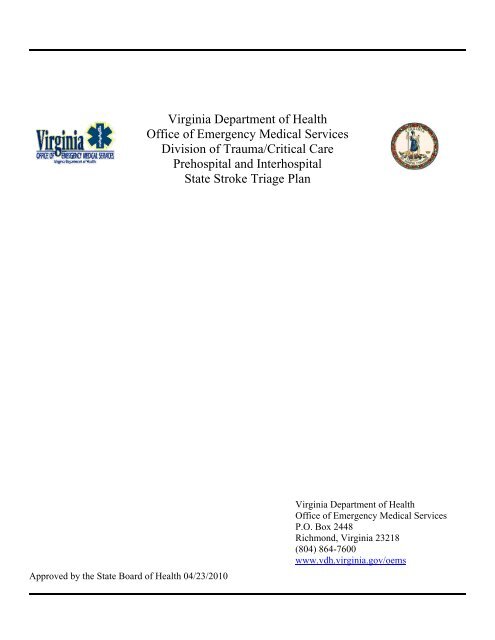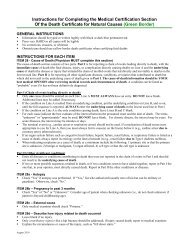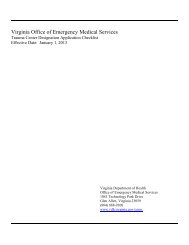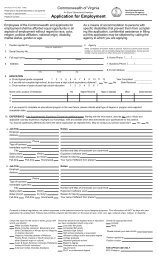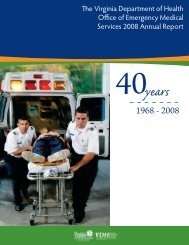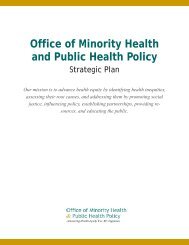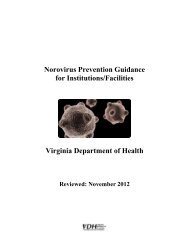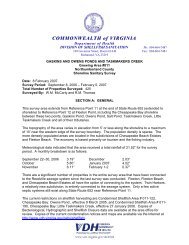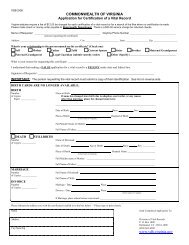State Trauma Triage Plan - Virginia Department of Health ...
State Trauma Triage Plan - Virginia Department of Health ...
State Trauma Triage Plan - Virginia Department of Health ...
You also want an ePaper? Increase the reach of your titles
YUMPU automatically turns print PDFs into web optimized ePapers that Google loves.
<strong>Virginia</strong> <strong>Department</strong> <strong>of</strong> <strong>Health</strong>Office <strong>of</strong> Emergency Medical ServicesDivision <strong>of</strong> <strong>Trauma</strong>/Critical CarePrehospital and Interhospital<strong>State</strong> Stroke <strong>Triage</strong> <strong>Plan</strong>Approved by the <strong>State</strong> Board <strong>of</strong> <strong>Health</strong> 04/23/2010<strong>Virginia</strong> <strong>Department</strong> <strong>of</strong> <strong>Health</strong>Office <strong>of</strong> Emergency Medical ServicesP.O. Box 2448Richmond, <strong>Virginia</strong> 23218(804) 864-7600www.vdh.virginia.gov/oems
IndexExecutive Summary 2Field Stroke <strong>Triage</strong> Decision Scheme 3Guidance Documents 4Acute Stroke Patients 6Designated Stroke Centers 7Interhospital <strong>Triage</strong> Considerations 8Stroke <strong>Triage</strong> Quality Monitoring 9Stroke Related Resources 101
Executive SummaryUnder the Code <strong>of</strong> <strong>Virginia</strong> § 32.1-111.3, The Office <strong>of</strong> Emergency Medical Services acting on behalf <strong>of</strong> the<strong>Virginia</strong> <strong>Department</strong> <strong>of</strong> <strong>Health</strong> has been charged with the responsibility <strong>of</strong> maintaining a <strong>State</strong>wide Stroke<strong>Triage</strong> <strong>Plan</strong>. The <strong>State</strong>wide Stroke <strong>Triage</strong> <strong>Plan</strong> establishes a strategy through formal regional stroke triage plansthat incorporate each region's geographic variations and acute stroke care capabilities and resources, includinghospitals designated as "Primary Stroke Centers" through certification by the Joint Commission or a comparableprocess consistent with the recommendations <strong>of</strong> the Brain Attack Coalition. The <strong>State</strong>wide Stroke <strong>Triage</strong> <strong>Plan</strong> isto include guidelines for prehospital patient care as well as inter-hospital patient transfers.The purpose <strong>of</strong> the <strong>State</strong>wide Stroke <strong>Triage</strong> <strong>Plan</strong> is to establish a uniform set <strong>of</strong> criteria for the prehospital andinter-hospital triage and transport <strong>of</strong> acute stroke patients. Formal regional or local stroke triage plans mayaugment the <strong>State</strong> Stroke <strong>Triage</strong> <strong>Plan</strong> to acknowledge and address variations with each region's EMS andhospital resources. This <strong>State</strong> Stroke <strong>Triage</strong> <strong>Plan</strong>, and the related regional plans, addresses patientsexperiencing an “acute stroke.” For the purposes <strong>of</strong> this document, “acute stroke” is defined as any patientsuspected <strong>of</strong> having an acute cerebral ischemic event or stroke with the onset <strong>of</strong> any one symptom within athree hour period. The primary focus <strong>of</strong> the plan is to provide guidelines to facilitate the early recognition <strong>of</strong>patients suffering from acute stroke and to expedite their transport to a Designated Stroke Center able to providedefinitive care within an appropriate time window.It is very important to note that because <strong>of</strong> the continuing evolution <strong>of</strong> scientific evidence indicating successfulmanagement <strong>of</strong> acute stroke greater than the three-hour time window, real-time contact with on-line medicalcontrol should be freely used to discuss individual cases outside the three-hour window. In selected cases itmay be determined that expeditious transfer or transport directly to a Designated Stroke Center may be <strong>of</strong>beneficial for a specific patient.Some selected acute stroke types may benefit from intervention up to 24 hours following symptom onset.Regardless <strong>of</strong> time <strong>of</strong> onset the sooner an acute stroke is treated, the better the potential outcome (“Time isBrain”). Based on a individual patient’s time <strong>of</strong> onset and following discussion with on-line medical control,consider what mode <strong>of</strong> transport would be most appropriate to transport the patient expeditiously to aDesignated Stroke Center.2
NIH/Cincinnati Prehospital Stroke Scale (CPSS)Guidance DocumentsAll patients suspected <strong>of</strong> having an acute stroke should undergo a formal screening algorithm such as theNIH/CPSS. Use <strong>of</strong> stroke algorithms has been shown to improve identification <strong>of</strong> acute strokes by EMSproviders up to as much as 30 percent. The results <strong>of</strong> the NIH/CPSS should be noted on the prehospitalmedical record. ANY abnormal (positive) finding which is suspected or known to be acute in onset isconsidered an indicator <strong>of</strong> potential acute stroke.F-(face) FACIAL DROOP: Have patient smile or show teeth. (Look for asymmetry)Normal: Both sides <strong>of</strong> the face move equally or not at all.Abnormal: One side <strong>of</strong> the patient's face droops.A-(arm) MOTOR WEAKNESS: Arm drift (close eyes, extend arms, palms up)Normal: Remain extended equally, drifts equally, or does not move at all.Abnormal: One arm drifts down when compared with the other.S-(speech) "You can't teach an old dog new tricks" (repeat phrase)Normal: Phrase is repeated clearly and correctly.Abnormal: Words are slurred (dysarthria) or abnormal (aphasia) or none.T-Time Time <strong>of</strong> SYMPTOM ONSET:_________________________________* Results <strong>of</strong> the F.A.S.T. should be included on the patient’s prehospital medical recordEMS Patient Care ProtocolsEMS patient care protocols for a patient suspected <strong>of</strong> having an acute stroke should include: An initial/primary assessment Focused assessment including:o Blood glucose level (if authorized to perform skill)o Documented time <strong>of</strong> onset or time last known to be normalo Cincinnati Prehospital Stroke Scaleo SAMPLE history to include mention <strong>of</strong> acute stroke mimics (i.e. seizures, migraines, hypo/hyperglycemia and others as deemed appropriate)o SAMPLE history to include potential thrombolytic exclusions (i.e. pregnancy, seizure at onset,terminal illness and others as deemed appropriate as on check sheet) Appropriate treatment for hypoglycemia. IV access and cardiac monitoring if available, reassessment <strong>of</strong>neurologic exam and stroke scale. Contact with medical control and/or the receiving hospital to advisethem that you are transporting a potential acute stroke patient. Transport criteria that direct acute stroke patients with a stable airway and without hypotension toDesignated Stroke Centers if time <strong>of</strong> onset is within 3 hours <strong>of</strong> EMS assessment. If symptoms are acute,but over the 3 hour window, on-line medical control should be freely used to discuss the individualpatient case to determine whether transport directly to a Designated Stroke Center would be <strong>of</strong> benefit inthat specific patient. EMS patient care protocols need to incorporate specific strategies appropriate to their area to assure thatacute stroke patients evaluated more than 3 hours from symptom onset can still potentially accessspecialty resources for acute stroke intervention and management. Examples may include partnershipswith acute stroke specialists at the Designated Stroke Center who can provide input on specific patientcases in a timely manner to either the on-line medical control physician or EMS provider/unit directly.4
For agencies or regions wishing to include a thrombolytic checklist in their EMS patient care protocolssee Appendix A for Sample Acute Stroke Thrombolytic Checklist. EMS does not determine whether apatient is excluded from any or all therapeutic options. Final decisions regarding patient eligibility forany given intervention will be determined by the receiving physician(s).5
Acute Stroke Patient Transport ConsiderationsMODE OF TRANSPORTATION: EMS Patient Care Protocols should address mode <strong>of</strong> transportconsiderations. Each jurisdiction is unique in its availability <strong>of</strong> EMS and acute stroke care resources.Consideration should be given to the hospital(s) that is/are available in the region and the resources that theyhave available to acute stroke patients when developing plans and protocols, as well as EMS system capacity.RAPID TRANSPORTATION: Because stroke is a time-critical illness, time is <strong>of</strong> the essence, and EMS shouldrapidly initiate transport once acute stroke is suspected. Consideration should also be given to prehospitalresources including use <strong>of</strong> helicopter EMS (HEMS) available at the time <strong>of</strong> the incident, and other conditionssuch as transport time and weather conditions. Use <strong>of</strong> HEMS can facilitate acute stroke patients reachingDesignated Stroke Centers in a timeframe that allows for acute treatment interventions. The likelihood <strong>of</strong>benefit <strong>of</strong> acute stroke therapy decreases with time, but there are several therapy options which <strong>of</strong>ferdefinite benefit outside the standard 3 hour window. Interventions may include any or all <strong>of</strong> the following:specialty physician or ICU capability, medical therapy (such as tPA or new experimental therapies), radiologicevaluation and procedures (MRI, intraarterial thrombolytics, mechanical thrombectomy), or life-savingemergent surgery (hemicraniectomy, large artery thrombus extraction).Field transports <strong>of</strong> acute stroke patients by helicopter as defined in this plan:1. Should significantly lessen the time from scene to a Designated Stroke Center compared to groundtransport2. Should be utilized to achieve the goal <strong>of</strong> having acute stroke patients expeditiously transported to aDesignated Stroke Center, ideally within three hours <strong>of</strong> symptom onset.3. Should only be to non-stroke centers in very unusual circumstances and after consultation with onlinemedical control. If a HEMS resource is used, the patient should be transported directly to aDesignated Stroke Center.6
Designated Stroke CentersThe Commonwealth <strong>of</strong> <strong>Virginia</strong> defines a Designated Stroke Center as a hospital that has achieved PrimaryStroke Center Certification by the Joint Commission. The process <strong>of</strong> Stroke Designation/Certification isentirely voluntary on the part <strong>of</strong> the hospitals and identifies hospitals that have established and maintain anacute stroke program that provides a specific level <strong>of</strong> medical, technical, and procedural expertise for acutestroke patients. Designation ensures that the hospital is prepared to provide definitive acute stroke care at alltimes and has an organized approach to providing clinical care, performance improvement, education etc. Thelist <strong>of</strong> Designated Stroke Centers in <strong>Virginia</strong> includes:Augusta Medical Center Richmond Inova Loudoun Hospital Center LeesburgBon Secours Maryview Med. Ctr. Portsmouth Inova Mount Vernon Hospital AlexandriaBon Secours Memorial Regional MC Richmond Martha Jefferson Hospital CharlottesvilleBon Secours Richmond Community Richmond Mary Washington Hospital FredericksburgBon Secours St. Francis Med. Ctr. Midlothian Riverside Regional Medical Center Newport NewsBon Secours St. Mary’s Hospital Richmond Sentara Leigh Hospital NorfolkCarilion Roanoke Memorial Hospital Roanoke Sentara Norfolk General Hospital NorfolkCentra Lynchburg General Lynchburg Sentara <strong>Virginia</strong> Beach General <strong>Virginia</strong> BeachChesapeake Regional Medical Center Chesapeake University <strong>of</strong> <strong>Virginia</strong> <strong>Health</strong> System CharlottesvilleCJW Medical Center Richmond VCU <strong>Health</strong> Systems RichmondHenrico Doctors’ Hospital Richmond <strong>Virginia</strong> Hospital Center ArlingtonInova Alexandria Hospital Alexandria Winchester Medical Center WinchesterInova Fairfax HospitalFalls ChurchNote: The list <strong>of</strong> hospitals becoming designated as stroke centers is increasing. A current list <strong>of</strong> The JointCommission Primary Stroke Centers that meet the definition <strong>of</strong> <strong>Virginia</strong> Designated Stroke Centers is availableat http://virginiastrokesystems.org/ or by entering the state <strong>of</strong> interest athttp://www.qualitycheck.org/consumer/searchQCR.aspx7
Interhospital <strong>Triage</strong> CriteriaWhen acute stroke patients cannot be transported directly to a Designated Stroke Center in a timely manner,ideally within the three-hour window, consideration may be given to transport to a closer hospital. Varioushospitals meet many <strong>of</strong> the components <strong>of</strong> a Designated Stroke Center based on national survey results andwould be the next logical choice. The closest hospital may not be the most appropriate hospital. Resourceinformation via self-reported data on the level <strong>of</strong> acute stroke care provided by hospitals which are notDesignated Stroke Centers is available at http://virginiastrokesystems.org/.These considerations should be addressed specifically within the regional plan in a manner consistent with thisstate stroke plan, and should be updated as hospital resource availability changes. The default destination foracute stroke patients should be a Designated Stroke Center. Stroke triage plans should provide guidance forsituations where patients would be transported to non-stroke centers, as well as specific guidance for use <strong>of</strong>HEMS for transport to Designated Stroke Centers.Non-stroke center hospitals should have transfer guidelines and agreements in place for the expeditiousand appropriate management <strong>of</strong> acute strokes when the care required exceeds their capabilities. This isespecially critical for transfer <strong>of</strong> patients following thrombolysis since specific protocols must be followedto diminish the risk <strong>of</strong> cerebral or systemic hemorrhagic complications.8
Stroke <strong>Triage</strong> Quality MonitoringThe <strong>Virginia</strong> Office <strong>of</strong> EMS, acting on behalf <strong>of</strong> the Commissioner <strong>of</strong> <strong>Health</strong>, will report aggregate acute stroketriage findings on an intermittent basis, but no less than annually, to assist EMS systems and the <strong>Virginia</strong> StrokeSystems Task Force to improve the agency, regional, and <strong>State</strong>wide Stroke <strong>Triage</strong> <strong>Plan</strong>s. A de-identifiedversion <strong>of</strong> the report will be available to the public and will include, minimally, as defined in the statewide plan,the frequency <strong>of</strong> (i) over and under triage to Designated Stroke Centers in comparison to the total number <strong>of</strong>acute stroke patients delivered to hospitals and (ii) interfacility transfers that do not meet criteria for transfer toDesignated Stroke Centers (iii) HEMS utilization. The program reports shall be used as a guide and resourcefor health care providers, EMS agencies, EMS regions, the <strong>Virginia</strong> Office <strong>of</strong> EMS, and the <strong>Virginia</strong> StrokeSystems Task Force. Additional specific data points to be collected within the EMS prehospital patient carereport (written or electronic) will be established collaboratively between OEMS and VSSTF. Information to becontained in routine reports on both system and patient-level indicators and outcomes will be developed byOEMS to guide further system development in a patient focused way.Hospitals, EMS agencies, and EMS Regions are encouraged to utilize their performance improvement programsto perform quality monitoring and improve the delivery <strong>of</strong> acute stroke care within their regions.Annual reporting on the <strong>State</strong> Stroke <strong>Triage</strong> <strong>Plan</strong> will typically be provided through the OEMS, Division <strong>of</strong><strong>Trauma</strong>/Critical Care’s “Trends” report and on an ad-hoc basis in response to appropriate inquiries.Stroke Related Resources<strong>Virginia</strong> Stroke System Web page: http://virginiastrokesystems.org/<strong>Virginia</strong> Office <strong>of</strong> EMS Stroke Web page: http://www.vdh.virginia.gov/OEMS/<strong>Trauma</strong>/Stroke.htmJoint Commission: http://www.jointcommission.org/CertificationPrograms/PrimaryStrokeCenters/9
Appendix A: Sample Thrombolytic ChecklistNOTE: Exclusions on this checklist are not absolute. Final decisions regarding patient eligibility for anygiven intervention will be determined by the receiving physician(s).Date:______________ Time:__________EMS Unit: ___________PHOTOCOPY THIS FORM ANDLEAVE COPY WITH EDPHYSICIAN OR NEUROLOGISTAT BEDSIDEPatient Name:___________________________________ Age:_________Estimated .weight:_______lbs/kg1. Did patient awaken with symptoms? Yes / No2. Time last known to be normal: _______________________3. Time <strong>of</strong> symptom onset: _________________________4. Onset witnessed or reported by: ___________________5. Witness/Family or other individual able to legally provide consent for treatment coming toEmergency <strong>Department</strong>? ______________ [ENCOURAGE TO DO SO].If not, phone # where such individuals will be immediately available for calls from hospital staff toassist in giving additional patient history and consent.Cincinnati Stroke Scale Score:( ) -Symptoms from Cincinnati Stroke Scale (circle abnormal findings)ANY ONE FINDING = POSSIBLE STROKE=MINIMIZE ON SCENE TIMEFACIAL DROOP: R LARM DRIFT: R L1 2 3SPEECH:slurred wrong words mute /unable to speakIndicate status for eachCurrent use <strong>of</strong> anticoagulants (e.g., warfarin sodium/Coumadin) Yes No ?Has blood pressure consistently over 185/110 mm Hg Yes No ?Witnessed seizure at symptom onset Yes No ?intracranial hemorrhage history Yes No ?GI or GU bleeding history within 3 weeks Yes No ?This event within 3 months <strong>of</strong> prior stroke Yes No ?This event within 3 months <strong>of</strong> serious head trauma Yes No ?This event within 21 days <strong>of</strong> acute myocardial infarction Yes No ?This event within 21 days <strong>of</strong> lumbar puncture (spinal tap) Yes No ?This event within 14 days <strong>of</strong> major surgery or serious trauma Yes No ?Is pregnant Yes No ?Abnormal blood glucose level (


